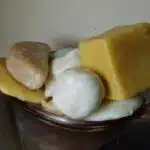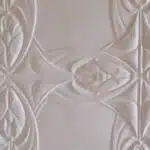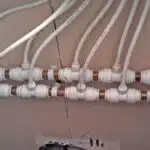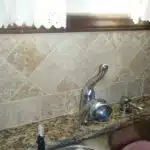A copper backsplash is an excellent addition to any kitchen or bathroom, providing a sleek and modern look while also being durable and long-lasting. Installing a copper sheet backsplash may seem like a daunting task, but with the right tools and approach, it can be done easily and efficiently. In this article, we will provide step-by-step instructions on how to install a copper sheet backsplash, from preparation to finishing touches.
Before starting your installation process, it’s important to consider the type of copper sheet that you want to use for your backsplash. There are many different types available on the market, ranging in thickness, finish, and texture. It’s important to choose one that matches your design aesthetic and fits within your budget. Once you have selected your desired copper sheet, you can begin the installation process by preparing the area and measuring out the necessary dimensions. With our comprehensive guide, you’ll be able to expertly install your own copper backsplash and add a touch of elegance to your home.
Choosing Your Copper Sheet
When it comes to installing a copper sheet backsplash, the first step is choosing the right copper sheet. There are several factors to consider when selecting your copper sheet, including thickness and finish.
Choosing thickness is important because it will determine how durable and long-lasting your copper backsplash will be. Thicker sheets are more durable and can withstand wear and tear better than thinner sheets. However, thicker sheets also tend to be more expensive, so it’s important to find the right balance between durability and cost.
Selecting finish is also an important consideration when choosing your copper sheet. Copper sheets come in a variety of finishes, including polished, brushed, hammered, and more. The finish you choose will depend on your personal style preference and the overall look you’re trying to achieve in your kitchen or bathroom. Keep in mind that certain finishes may require more maintenance than others, such as polishing or cleaning to maintain their shine.
Now that you understand the importance of choosing the right copper sheet for your backsplash project, it’s time to move on to measuring your space. By accurately measuring your space, you’ll be able to ensure that you purchase enough copper sheeting for your project without overbuying or underestimating.
Measuring Your Space
Accurately measuring walls is essential for a successful copper sheet backsplash installation. Carefully measure the length and width of the area to be covered and note any obstacles. After taking measurements, estimate the amount of copper sheet material needed to complete the project. Add an extra 10-15% to the material estimate to account for any errors or unexpected changes.
Measuring Walls
Measuring your walls is a crucial step when installing a copper sheet backsplash. Measuring accuracy is essential to ensure that you purchase the correct amount of copper sheets and get an accurate quote for installation costs. It’s important to measure each wall separately, even if they appear to be the same size.
Wall texture can also impact measuring accuracy. If your walls have a textured surface, such as stucco or brick, it’s recommended that you add an additional 10% to your measurements to account for any irregularities in the surface. This will ensure that you have enough copper sheets to cover the entire area without any gaps or overlaps.
Before taking any measurements, make sure that the walls are clean and free of any debris or obstructions. Use a tape measure to take precise measurements from floor to ceiling and from corner to corner. Record all measurements accurately and double-check your work before ordering your copper sheets. By taking these precautions, you’ll be well on your way to achieving a beautiful and seamless copper sheet backsplash installation.
Estimating Materials
Now that you have measured your space accurately, it’s time to estimate the materials needed for your copper sheet backsplash installation. Estimating accuracy is crucial to ensure that you purchase the correct amount of copper sheets and adhesive for the project. By accurately estimating the materials, you can avoid overspending and choose cost-effective options.
To estimate the number of copper sheets required, multiply the width of each wall by its height. If there are any obstacles such as outlets or switches, measure their dimensions and subtract them from the total area measurement. It’s recommended that you order extra copper sheets to account for any errors or unexpected changes during installation. Additionally, consider purchasing a few extra sheets in case of future repairs or replacements.
When estimating adhesive requirements, consult with a professional installer or follow manufacturer instructions carefully. Required amounts may vary depending on the type of adhesive used and surface texture. Choosing cost-effective options for materials can save money without compromising quality. With accurate measurements and material estimation, you’ll be well on your way to achieving a beautiful copper sheet backsplash installation that will last for years to come.
Gathering Your Tools And Materials
Before you start with the installation of your copper sheet backsplash, you need to gather all the necessary tools and materials. Using the right adhesive is crucial for a successful installation. For this project, it is best to use an adhesive that is specifically designed for copper sheets. This will ensure that the copper adheres well to your wall and does not peel off over time.
When choosing the right adhesive, make sure to read the label carefully and follow the manufacturer’s instructions. Some adhesives require mixing before use, while others come ready-to-use. It is also important to choose an adhesive that is waterproof and heat-resistant since it will be exposed to moisture and heat from your stove or sink.
Safety precautions are also essential when installing a copper sheet backsplash. Make sure to wear protective gear such as gloves, safety glasses, and a mask when working with adhesives or cutting tools. Keep all sharp objects away from children and pets, and work in a well-ventilated area to prevent inhaling fumes from adhesives.
Transition: Now that you have gathered all your tools and materials and taken adequate safety measures, it’s time to prepare your work area for installation.
Preparing Your Work Area
Before diving into installing a copper sheet backsplash, it is important to prepare your work area. This not only ensures a smooth installation process but also promotes safety during the project. Creating a well-organized workspace can increase productivity and reduce accidents.
To start, clear your work area of any clutter or unnecessary items. This allows for easy access to all tools and materials needed for the installation. Consider setting up a separate space specifically for this project, as it minimizes distractions and promotes focus. Labeling containers and organizing tools by size and type can also prevent confusion and save time.
Safety should always be a top priority when working with any kind of material, especially metal. During the installation process, wear protective gloves to avoid cuts from sharp edges and goggles to protect your eyes from flying debris. Additionally, use caution when handling tools such as saws or drills. Always read instructions carefully before using any equipment and follow manufacturer’s recommendations for safe operation.
With your workspace organized and safety precautions in place, you are ready to move on to the next step: cutting your copper sheet.
Cutting Your Copper Sheet
Now that you have prepared your work area, it’s time to move on to the next step, which is cutting the copper sheet. Using a cutting tool, such as tin snips or shears, will help you shape the copper sheet according to your desired size and shape. Before you start cutting, make sure that the sheet is clean and free from any debris or grease.
One common mistake when cutting a copper sheet is using too much force or pressure. This can result in uneven cuts or even damage to the sheet itself. To avoid this, start with light cuts and gradually increase the pressure until you reach your desired cut. Another tip for cutting a curved shape is to make small cuts along the curve rather than one long cut.
While cutting your copper sheet, it’s important to take safety precautions to prevent injury. Wear protective gloves and eye goggles to protect yourself from metal shavings and sharp edges. Also, be sure to secure the sheet firmly in place before starting to cut to avoid any slipping or movement that could result in unwanted cuts or injuries.
Transition: Now that you have successfully cut your copper sheet, it’s time to move on to applying adhesive onto your wall.
Applying Adhesive To Your Wall
When selecting an adhesive for a copper sheet backsplash, it is important to choose one that is specifically designed for metal surfaces. Preparing the wall for adhesive application is essential for a successful installation; any remaining dust, dirt, or grease should be removed, and the surface should be roughened to create a better bond. Applying adhesive is the next step; a thin, even layer of adhesive should be spread onto the wall using a trowel or roller, leaving no gaps or air bubbles.
Choosing Adhesive
Applying adhesive to your wall is one of the most crucial steps in installing a copper sheet backsplash. Before you start, it’s essential to choose the right adhesive for your project. Comparing adhesives can be overwhelming, especially if you’re a beginner. However, with the right information and tips, you can make an informed decision.
Firstly, consider the type of surface that your copper sheet will be adhered to. If it’s a porous surface like drywall or plaster, choose a heavy-duty adhesive that won’t break down over time. On the other hand, if your surface is non-porous like tile or metal, opt for a silicone-based adhesive that offers excellent bonding strength.
Secondly, pay attention to drying time. Some adhesives require more time than others before they set permanently. If you’re working on a large project or have limited experience with applying adhesive, choose an adhesive that allows for some repositioning as it dries. This way, you have more flexibility to adjust the placement of your copper sheet if needed.
In conclusion, choosing the right adhesive is crucial when installing a copper sheet backsplash. By comparing adhesives and following these tips for beginners, you’ll ensure that your project goes smoothly and that your backsplash looks great for years to come. Remember always to read and follow manufacturer instructions for best results!
Preparing The Wall
Now that you have chosen the right adhesive for your copper sheet backsplash project, it’s time to prepare your wall. Wall prep techniques are essential to ensure that the adhesive bonds correctly and that your backsplash looks smooth and even. Before starting the installation process, take some time to assess your wall’s condition and make necessary repairs.
Begin by cleaning your wall thoroughly with soap and water, then rinse it with clean water and let it dry completely. Next, inspect your wall for any cracks, holes, or bumps. If you notice any imperfections, use spackle or joint compound to fill them in. Sand down any rough spots until they’re smooth to the touch. This step is crucial because an uneven surface can cause the adhesive not to bond correctly.
Once you’ve repaired any damage and smoothed out your wall’s surface, prime it with a high-quality primer designed for DIY backsplash inspiration projects. The primer will help the adhesive adhere better to the surface and increase its bonding strength. Let the primer dry completely before moving on to applying the adhesive. With these simple yet essential wall prep techniques in mind, you’ll be on your way to a successful copper sheet backsplash installation in no time!
Applying Adhesive
Now that you have prepped your wall for the backsplash installation, it’s time to apply the adhesive. Using different adhesives can be tricky, so it’s essential to follow the manufacturer’s instructions carefully. Some adhesives require mixing, while others come ready-to-use. Regardless of which adhesive you choose, there are tips for applying it evenly.
First, use a trowel or notched spreader to apply the adhesive to the wall. Begin at one corner and work your way across the surface in small sections. Spread the adhesive evenly and make sure you cover the entire area where you’ll be placing the copper sheets. Use a notched spreader to create grooves in the adhesive; this will help ensure that it adheres correctly.
Once you’ve applied the adhesive to one section of the wall, gently press your copper sheet into place, making sure it lines up correctly with your guidelines. If any excess adhesive seeps out from under your copper sheet, wipe it away immediately with a damp cloth or sponge. Continue this process until all of your copper sheets are in place. By following these tips for applying adhesive evenly, you’ll achieve a smooth and professional-looking finish that will last for years to come!
Securing Your Copper Sheet
How can you ensure that your copper sheet backsplash stays securely in place? One crucial step is adjusting the placement of the sheet before adhering it to your wall. This will allow you to make any necessary modifications before the adhesive sets.
To adjust the placement of your copper sheet, hold it up against the wall and mark where it needs to be trimmed or adjusted. Use a pair of sharp scissors or tin snips to cut the sheet down to size. Once you are satisfied with its fit, apply a high-quality adhesive directly onto your wall and press the copper sheet firmly into place.
In addition to adjusting placement, enhancing durability is also key. You can do this by applying a sealant over the top of your completed backsplash, which will protect it from scratches and other forms of damage. With these steps taken care of, your copper sheet backsplash will stay looking great for years to come as you move on to cutting out your outlets and switches.
Cutting Out Your Outlets And Switches
Outlet placement and switch dimensions are essential considerations when cutting out your copper sheet backsplash. You need to measure the distance between outlets and switches accurately and transfer them onto the copper sheet. This process is crucial, as it ensures that you have a neat and well-fitting backsplash that accommodates your outlets and switches.
Before beginning, turn off the power supply to the outlets and switches you will be working on. Then proceed to cut out the shape of each outlet or switch using tin snips or a jigsaw. It is advisable to start with smaller cuts around the corners before proceeding with longer cuts along the sides. As you work, ensure that you file away any sharp edges or rough spots on the copper sheet.
Once all your outlets and switches are cut out, hold up your copper sheet against the wall to ensure a snug fit over your electrical fixtures. Make any necessary adjustments by filing down any excess material until it fits comfortably in place. With this step complete, you are ready to move on to applying caulk to seal seams between sections of your backsplash without gaps or holes!
Applying Caulk To Your Seams
With your outlets and switches taken care of, it’s time to move on to the next step in installing your copper sheet backsplash. Before applying the sheet, you’ll need to ensure that your seams are properly sealed. This will help prevent any moisture from seeping through and damaging your walls. The best caulk types for this job are silicone or latex as they are both waterproof and flexible.
When applying caulk to your seams, there are a few tips for smooth application that can make all the difference. First, ensure that the surface is clean and dry before you start. Next, use a caulk gun rather than trying to apply it by hand – this will give you more control over the flow of caulk and allow for a more even distribution of product. Finally, don’t be afraid to use a lot of caulk – it’s better to have too much than not enough.
Once your seams have been properly sealed with caulk, you’re ready to move on to preparing for finishing touches. This involves ensuring that your copper sheet is cut precisely and fits snugly against the wall. You may need to trim some pieces or make adjustments along the way, but with patience and careful attention to detail, you’ll have a beautiful copper backsplash in no time!
Preparing For Finishing Touches
Now that you have successfully installed your copper sheet backsplash, it is time to prepare for the finishing touches. It is important to keep in mind that this step should not be rushed as it will greatly affect the final outcome of your project. There are several ways to customize your backsplash to match your design preferences and create a unique look.
One way to customize your copper sheet backsplash is by adding a patina finish. This can be achieved by applying a mixture of vinegar and salt to the surface of the copper sheet, creating an aged and weathered look. Another option is to polish the surface using a brass or copper cleaner, providing a shiny and reflective finish. It is important to note that these methods should only be done after ensuring proper safety measures are in place.
Speaking of safety, it cannot be emphasized enough how crucial it is when working with metal sheets. Always wear protective gear such as gloves, goggles, and a mask when cutting or handling the material. Ensure that all tools used are sharp and properly maintained to avoid any accidents from occurring.
In preparing for the finishing touches of your copper sheet backsplash, take the time to explore different customization options and prioritize safety. With these factors in mind, you will be able to achieve the desired outcome for your project while keeping yourself and others safe. Next up on our list is sanding your copper sheet – an essential step in achieving a smooth and polished finish for your backsplash.
Sanding Your Copper Sheet
Sanding your copper sheet is an essential step in preparing it for installation as a backsplash. It helps to remove any imperfections on the surface of the copper and create a smooth finish. Before sanding, ensure that your copper sheet is clean and dry. This will prevent any dirt or debris from getting trapped in the sandpaper.
Tips for sanding copper include using a fine-grit sandpaper, such as 220 or 320 grit, to avoid scratching or damaging the surface of the metal. Additionally, you should always sand in one direction to maintain a consistent finish. To avoid overheating the copper, it is best to use light pressure when sanding. Finally, be sure to wipe down your copper sheet with a clean cloth after sanding to remove any remaining dust or particles.
The best sandpaper for copper is aluminum oxide sandpaper, which has a durable and long-lasting abrasive surface that can handle tough materials like metal. Other types of sandpaper, such as silicon carbide or garnet paper, may not be suitable for use on copper as they can wear out quickly or scratch the surface of the metal. By following these tips and using high-quality sandpaper, you can achieve a polished and smooth finish on your copper sheet before installing it as a backsplash.
As you finish up your sanding process, remember that oiling your copper sheet is an important next step in ensuring its longevity and shine. Applying oil will help protect your backsplash from scratches and other damage while also enhancing its natural color and texture. Keep reading to learn more about how to properly oil your newly sanded copper sheet for optimal results.
Oiling Your Copper Sheet
Once your copper sheet backsplash is installed, it’s important to protect it from oxidation, which can cause it to turn green over time. One way to do this is by oiling the copper regularly. The benefits of oiling your copper sheet include protecting it from fingerprints, scratches, and other damage that can occur during daily use. In addition, oiling helps to maintain the natural shine and patina of the copper.
When choosing an oil for your copper sheet, it’s important to choose one that won’t leave a residue or discolor the metal. Some of the best oils to use for this purpose include mineral oil, olive oil, and beeswax. Mineral oil is a popular choice because it doesn’t go rancid over time and won’t affect the color of the metal. Olive oil is another good option because it’s affordable and easy to find at most grocery stores. Beeswax is also a great choice because it creates a protective barrier on top of the metal that helps to prevent oxidation.
To apply the oil to your copper sheet backsplash, simply pour a small amount onto a soft cloth and rub it onto the surface in circular motions. Be sure to cover all areas evenly and wipe away any excess with a clean cloth. You should aim to oil your copper sheet every few months or as needed depending on how often you use your kitchen. By doing so, you’ll help keep your backsplash looking beautiful for years to come.
As important as oiling your copper sheet is cleaning it regularly as well. By keeping up with regular cleaning habits, you will extend its life span even further while maintaining its beauty.
Cleaning Your Copper Sheet
- Grease and dust can easily accumulate on copper sheeting, making it difficult to maintain its glossy, attractive appearance.
- To remove grease from copper sheeting, it is important to use a non-abrasive cleaner and a soft cloth.
- For tougher grease stains, a copper polish or a gentle cleaning solution can be used to restore the sheet’s shine.
- To polish copper sheeting, use a soft cloth and a copper polish or a mild detergent to remove tarnish and restore its luster.
Removing Grease
Dealing with grease buildup on your copper sheet backsplash can be an overwhelming and frustrating task. However, it is a necessary part of maintaining the beautiful appearance of your kitchen. Luckily, there are several effective methods for removing grease without causing any damage to your copper surface.
One way to remove grease from your copper sheet is by using a mixture of baking soda and water. Simply create a paste by combining equal parts of baking soda and water, then apply it to the affected areas with a soft cloth or sponge. Allow the mixture to sit for 10-15 minutes before rinsing it off with warm water. This method is gentle enough to avoid causing any damage while still being effective at removing tough grease stains.
Another effective option for removing grease from your copper sheet is by using vinegar. Mix equal parts of white vinegar and water in a spray bottle, then generously spray the affected areas. Let it sit for a few minutes before wiping away with a soft cloth or sponge. Vinegar is acidic and works well at breaking down greasy residue without damaging your copper surface.
In conclusion, removing grease from your copper sheet backsplash doesn’t have to be a daunting task. By using these simple methods, you can effectively rid your surface of unsightly grease buildup while avoiding any potential damage. Remember to always use gentle materials when cleaning your copper sheet and avoid harsh chemicals that can cause irreversible harm to this beautiful material.
Polishing Copper
After removing the grease buildup on your copper sheet backsplash, it’s time to polish your copper surface to maintain its lustrous appearance. There are various polishing techniques available that you can use to achieve a shiny and reflective surface. Polishing your copper sheet is not only about aesthetics but also has practical benefits. Polished copper is less likely to tarnish, corrode, or accumulate dirt and grime.
One of the most common polishing techniques for copper is using a commercial metal polish. These products are readily available in hardware stores and contain abrasive particles that effectively remove stains, oxidation, and tarnish from your copper surface. To use, apply a small amount of the metal polish onto a soft cloth or sponge and rub gently onto your copper sheet in circular motions until you achieve the desired shine.
Another effective method for polishing your copper sheet is by using natural ingredients such as lemon juice or tomato ketchup. The citric acid in lemon juice and acetic acid in ketchup work as mild acids that dissolve any tarnish on your copper surface while also leaving behind a protective layer that prevents further oxidation. Apply either of these substances onto the affected areas with a soft cloth or sponge, then rinse off with warm water after 10-15 minutes.
In summary, polishing your copper sheet is an essential part of maintaining its beauty and functionality. Using commercial metal polish or natural ingredients such as lemon juice or tomato ketchup are effective methods for achieving a shiny and reflective surface while also protecting against tarnish and corrosion. With proper care and maintenance, your copper sheet backsplash will continue to be an attractive feature in your kitchen for years to come.
Maintaining Your Copper Backsplash
After installing a copper sheet backsplash, it is important to maintain its beauty and shine. This can be achieved through regular cleaning and preventing oxidation.
Cleaning tips for your copper backsplash include using a soft cloth or sponge, warm water, and mild dish soap. Avoid abrasive scrubbers or harsh chemicals as they can damage the finish. Dry the surface thoroughly with a clean cloth after cleaning to prevent water spots.
Preventing oxidation is key to maintaining the appearance of your copper backsplash. Apply a protective sealant to the surface every few months to ward off tarnishing. Additionally, avoid placing acidic foods or liquids directly on the copper surface as they can cause discoloration. By following these tips, you can enjoy your beautiful copper backsplash for years to come.
As important as maintenance is, sometimes issues may still arise with your copper backsplash. If you notice any discoloration or damage, there are troubleshooting steps you can take to address the issue and restore its original look.
Troubleshooting Common Issues
Common mistakes can occur when installing a copper sheet backsplash. One of the most common mistakes is not properly measuring the area where the backsplash is to be installed. This can lead to cutting the copper sheet too small or too big, resulting in an unattractive and ill-fitting installation. Another mistake is not properly preparing the surface before installation. The surface should be cleaned and free of any debris or residue that may prevent proper adhesion of the copper sheet.
To troubleshoot these issues, it is important to measure twice before cutting to ensure accuracy in sizing. Additionally, using a template or stencil can aid in achieving precise measurements and cuts. Proper preparation of the surface involves cleaning with a degreaser and allowing it to completely dry before installation. Using a primer or adhesive promoter can also help ensure proper adhesion.
Another common issue when installing a copper sheet backsplash is incorrect placement or uneven spacing between sheets. To avoid this, use spacers between each sheet during installation to ensure even spacing and straight lines. It is also important to regularly step back and assess the overall appearance of the installation during the process.
| Common Mistake | Troubleshooting Tip |
|---|---|
| Improper measurement | Measure twice before cutting, use templates/stencils for accuracy |
| Inadequate surface preparation | Clean with degreaser, allow surface to dry completely |
| Incorrect placement/uneven spacing | Use spacers between sheets for even spacing & regularly assess overall appearance during installation |
By following these troubleshooting tips, common issues that arise during the installation of a copper sheet backsplash can be avoided or easily corrected. Taking time to properly measure, prepare surfaces, and maintain even spacing will result in an attractive and functional addition to any kitchen or bathroom space. Remember that attention to detail throughout the process will lead to beautiful results that will last for years to come.
Conclusion
Installing a copper sheet backsplash can be an exciting and rewarding project for any homeowner. With proper planning, preparation, and execution, you can create a stunning focal point in your kitchen or bathroom that will last for years to come. By following the steps outlined in this article, you can confidently install your own copper sheet backsplash.
Remember to choose a high-quality copper sheet that fits your style and budget, carefully measure your space, gather all necessary tools and materials, prepare your work area, cut and oil your copper sheet, clean it thoroughly before installation, and maintain it regularly to prevent damage. If you encounter any issues during the installation process, don’t hesitate to troubleshoot or seek professional assistance.
In the end, installing a copper sheet backsplash is not just about adding beauty and functionality to your home; it’s also about expressing yourself creatively and enhancing your living space. So go ahead and embrace the challenge of this DIY project – it may just inspire you to tackle other home improvement tasks with confidence and creativity!
Image Credits
- “brown wooden round barrels on brown wooden floor” by Karim Ghantous (featured)

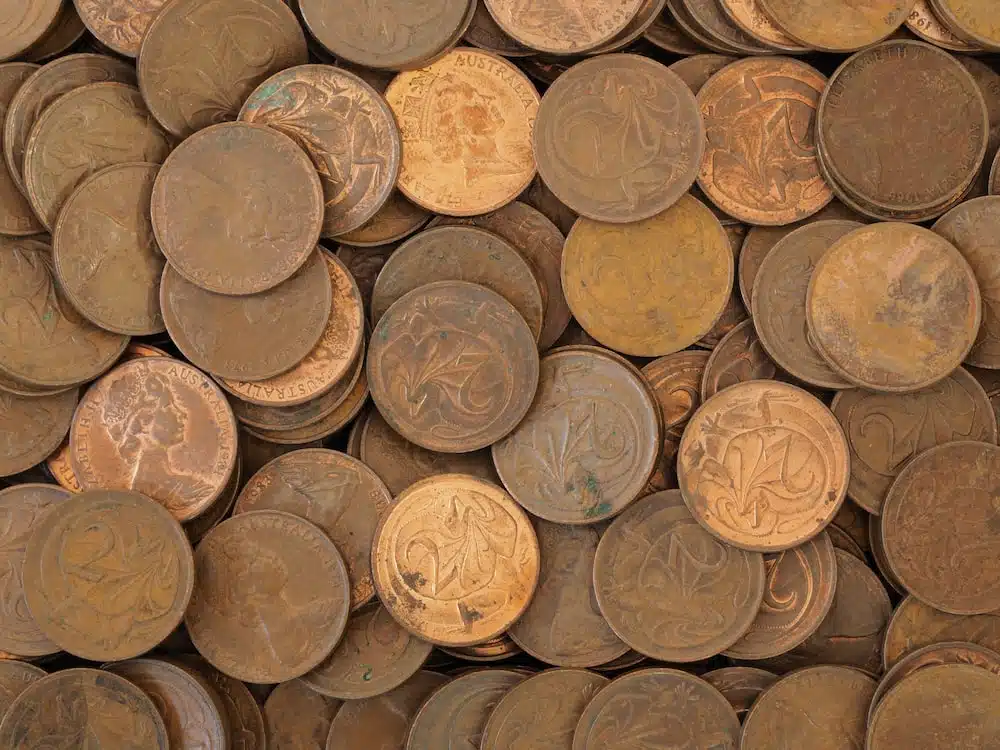
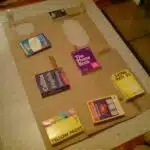



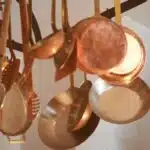


![How To Keep Sheets On A Bed: 10 Strategies 9 Bed sheets [Explored 2013-04-27]](https://green-life.blog/wp-content/uploads/2023/04/pH7FwL8jspjq-150x150.jpg.webp)

